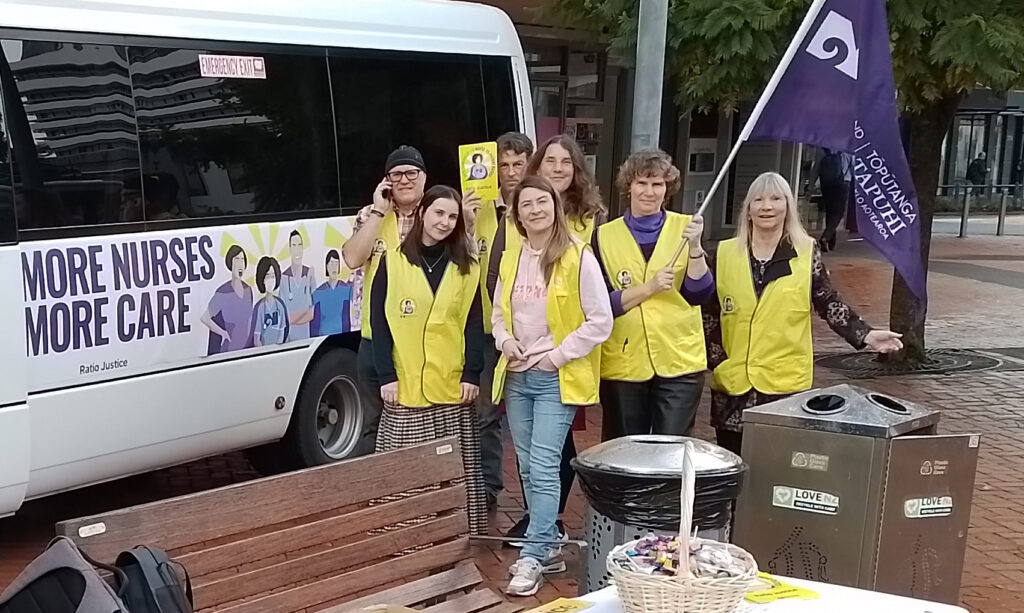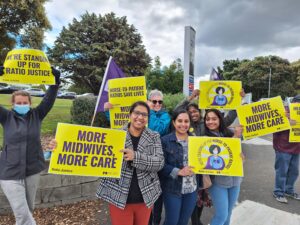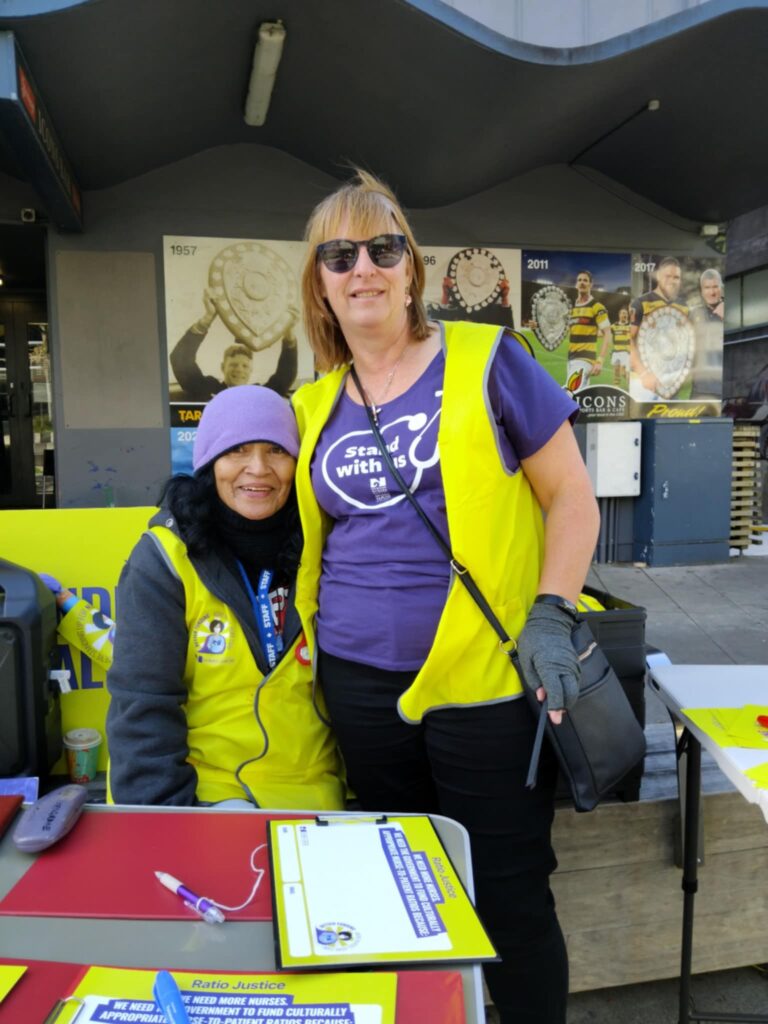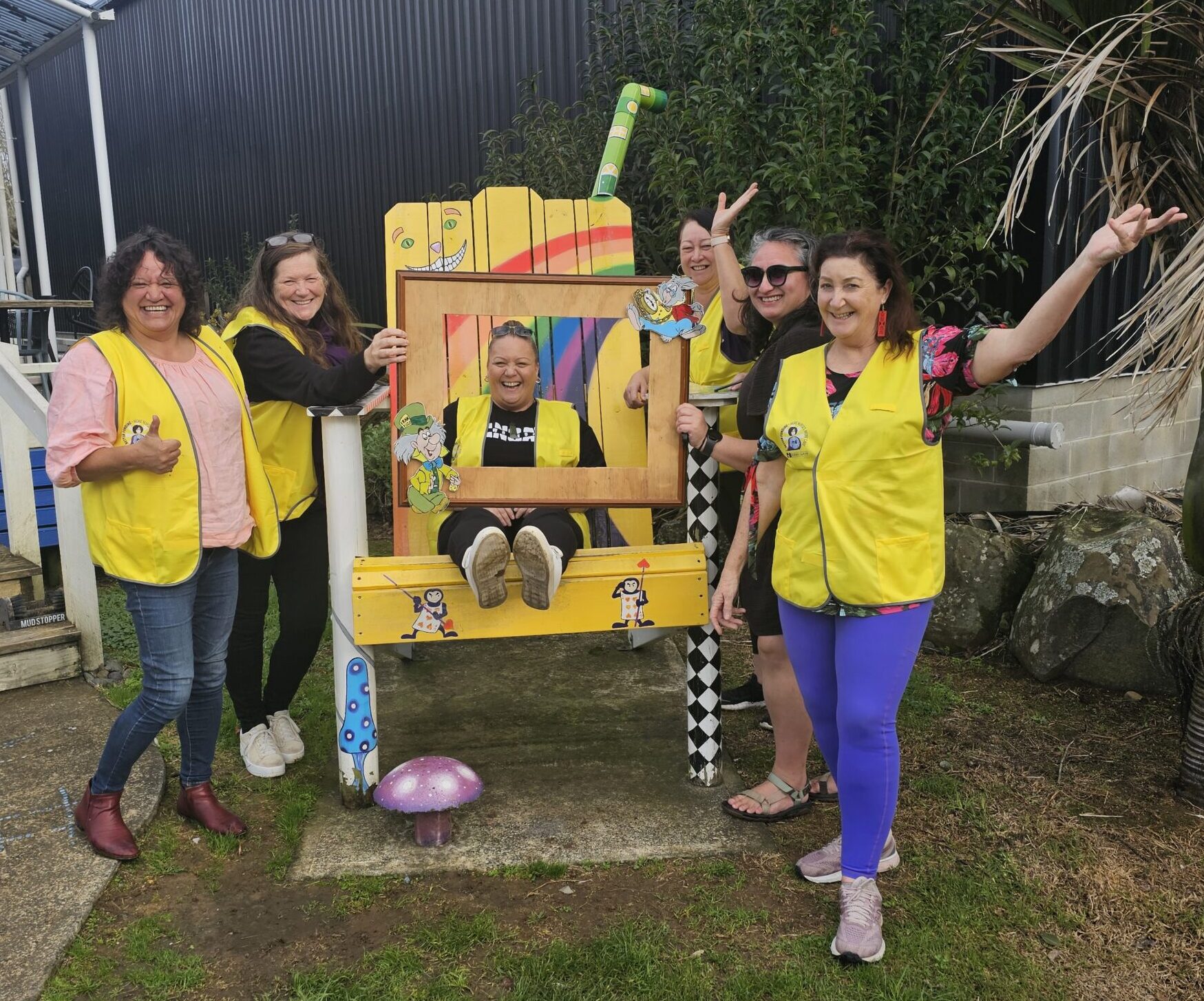A Hamilton ‘day in the life’ on the ratio justice tour

By Katrina Pepper
I got a bit mixed up where to meet but [NZNO organiser] Nigel Dawson said, ‘No worries, we haven’t left yet’. I first went to the NZNO office car park where Nigel was, but I couldn’t see him, so went to Garden Place. I gave him a call to track him down, went back to NZNO and helped load up some gear on the bus. The bus driver was lovely, everyone from the union was there and before long the bus was ready to roll!
We arrived at Garden Place and set up the tables and put some ratio justice posters up on the bus.
The first gent who came up took heaps of lollies. We politely said, ‘Save some for other people’. I felt for him as he was perhaps homeless and these are the people we need to help the most.
Anyway we got our little posters together and the cards to write up ‘more nurses, ratio justice’ and headed off to all the different directions around town. I thought the mall would be ideal — and it was, as I was able to get people’s attention after or before crossing, and in the mall itself as well.
I heard many stories over the morning about people’s experiences with health care. One lady said her son has been waiting for an appointment at the neurology clinic for a couple of years now, after being attacked by his ram. Her daughter helps care for him, as there is no funding available. I said I was in the same boat with my mum too.
A lot of people were concerned about how many nurses would be on the floor if they go into hospital for care, or if a family/whānau member was in need of nursing care. I met a couple of young ladies who said they don’t qualify for zero fees, so why bother studying? They said they can’t afford it with the cost of living.
It was busy and time was going fast, before a towering security guard sent me on my merry way.
By the time I came out of the mall, it was 11.45am and I decided to go back to Dunkin Donuts for a hot choc and two donut special. Nigel soon came and told me it was time to get back on the bus and head to Waikato Hospital for the next stop.
I met registered nurse, Janferie Dewar, and a couple of other nurses there and off we went to gather more support.
Everyone we met was very supportive and worried about ratio justice for nurses and how safe our staffing ratios will be in the future.
Lots of our ratio justice cards were filled in by members of the public and photos taken.
I’m glad I was a part of the ratio justice tour in Hamilton. It is an important time as we are living through a health crisis and NZNO is doing the best to get the message out there for all the public of New Zealand to know.
We can’t just sit back and let it continue — everyone has to do their bit to help and not ignore it. We never know — we could be the next ones to be sick.
I’m also concerned about student loans as there are changes bringing higher interest rates and a late payment fee for the next generation in training if they don’t meet the zero fees criteria. Something to definitely think about — it opened my eyes up, and I’m glad I went.
I wish to thank everyone on the ratio bus and all the nurses, health-care assistants and public who took part.
— Katrina Pepper is a Waikato health-care assistant.
The ratio justice bus tour ran for nearly two weeks, travelling from Kaitāia to Bluff, in a resounding call to fund culturally and clinically safe nurse/midwife-to-patient ratios that reflect Aotearoa’s communities. It finished on June 21.
Whanganui registered nurse (RN) Adrienne Kellow said the tour was “amazing” with high public interest and she hoped it would bring more support for nurses.
“People were really supportive, encouraging, interested — it was simple.”
On Kellow’s ward, where she worked nights, she routinely looked after 11 to 12 patients instead of eight. “It doesn’t sound like much difference, four, but it’s actually quite an incredible difference,” she told Kaitiaki.

“People think that patients sleep all night but some people don’t sleep one wink,” she said.
“[Having safe staffing] just means you can slow down and do things more timely and more effectively — and the patients notice. They most definitely notice when you’re in a hurry or when you’ve got an extra couple of minutes.”
Kellow said it wasn’t just about money. “It’s about making it a more appealing job that you can do effectively and not be comparing yourself to what’s happening in Australia.”
Over the ditch, she said nurses knew that they could “look after less patients, do the job more effectively, get more satisfaction, have less stress — so why would I stay here?”
So, opening a conversation on mandated ratios was a good thing, she said.
Taranaki RN Wendy Alexander said the day had been “very well-received” in the community.

“We didn’t even have to explain what we were there for, and they said ‘let me sign’. They, too, want more nurses on the floor and more funding for the health sector.”
Alexander — who also works nights shifts — said unsafe staffing levels affected her and colleagues “hugely”.
“Just not enough staff on the floor. Not being able to feel like you’ve done a good enough job. It’s not unusual to walk out of work an hour late, because you feel bad that you’re leaving so many things for the day staff to do that you didn’t get done.”
A senior nurse, Alexander rarely took breaks. “There is nobody to relieve you . . . I feel it’s more important for my junior staff to take breaks than myself, because they’re the future.”

Recent cutbacks had made things worse, with no pool nurses to do things like close cares — which meant health-care assistants (HCAs) had to take on those nursing jobs.
Alexander wanted to believe the Government had the public’s best interest at heart — and hoped to see a willingness to safely staff the country’s hospitals and health system.
“I would have thought that was a reasonable thing to ask. And the only way that’s going to happen is to grow our own, to nurture those who are there – because they’re all skipping over to Australia because it’s better conditions,” she said.
“We need to keep fighting.”
NZNO — Tōpūtanga Tapuhi Kaitiaki o Aotearoa is campaigning for legislated nurse-to-patient ratios, as have been introduced in California, British Colombia (Canada), Ireland, Wales and many parts of Australia.
Queensland introduced patient ratios in 2016 for acute medical and surgical wards, and some mental health units, after nearly 10 years of lobbying by the Queensland Nurses & Midwives Union (QNMU). In 2019, it was extended to all adult acute mental health wards. In 2023, Queensland also committed to implement midwifery ratios in all public maternity wards by 2026.
NZNO’s He Tipu conference in Wellington July 2-3 is bringing local and international experts in nursing and safe staffing together to explore solving the nursing crisis and attaining culturally safe care.




























